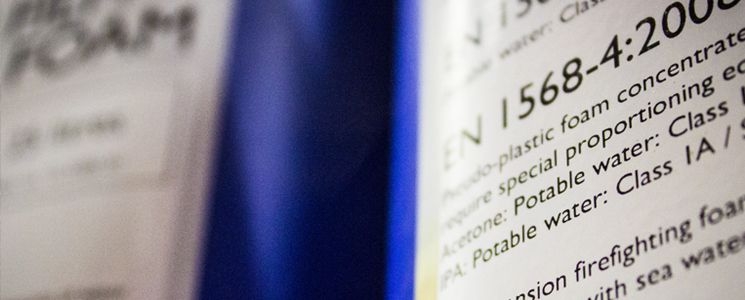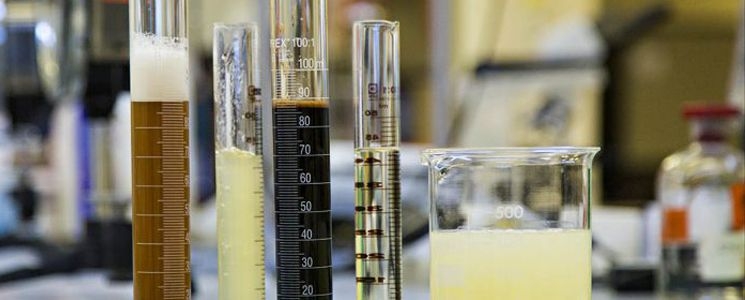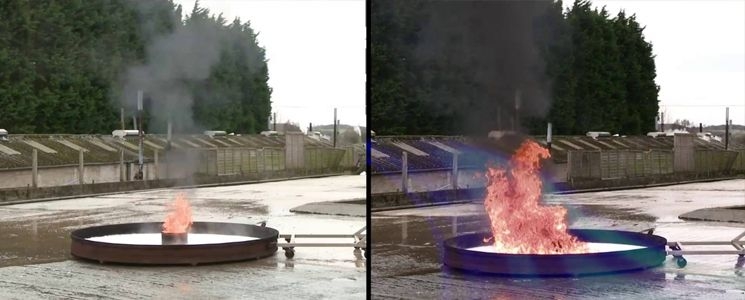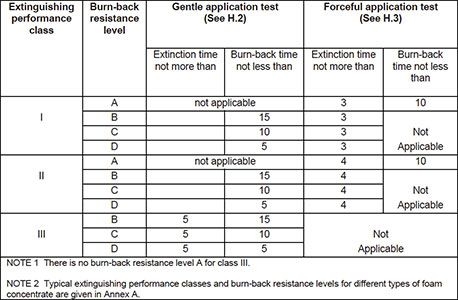 06/07/2017
06/07/2017
How do you determine the quality of your extinguishing foam?
Extinguishing foam is available in several qualities. The qualities of the various extinguishing foams greatly differ. The type of extinguishing foam that you need therefore depends on the type of fire, but also for example on the size of the fire. But how is the quality of extinguishing foam determined? And how do you know which quality meets your specific situation? But how is the quality of extinguishing foam determined? And how can you examine yourself whether a certain type of extinguishing foam has the required quality?
Difference in quality: different foam qualities
The foam qualities of the various extinguishing foams vary greatly. Some types of foam are known that they can quickly extinguish a fire, while other foams have the best qualities for preventing re-ignition.
However, there are sometimes also great differences in quality between foams of the same type. For example, a certain type of AFFF may be very suitable for extinguishing puddle fires, while another type of AFFF may be more suitable for 3D fires and sprinkler systems. The question is therefore which quality of extinguishing foam is most suitable for a certain application. The answer to this question is not easy. It greatly depends on the nature and extent of the fire, but also on the targets that must be achieved when the fire is extinguished.
The right extinguishing foam; different fire scenarios
Two example scenarios: a petrol fire in in a PGS29 storage tank and an overturned tank truck with the same substance which is burning on the motorway. The large storage tank could continue to burn several days and in the worst case this fire could escalate into a large (environmental) disaster. The control strategy therefore soon focuses on extinguishing. In the Netherlands such storage tanks must also have (semi-)stationary extinguishing foam systems. it is usually also decided to extinguish the fire in case of a burning tank truck. This is done by definition with a mobile system. Hereby the chance of escalation is zero.
If the (semi-)stationary system is not successful in extinguishing the fire, this is followed by an enormous logistical operation. On the other hand, the scenario on the motorway can be tackled with only a few firemen. A single tank truck hose already provides a more than sufficient flow rate to quickly extinguish this shallow puddle fire with one or two foam nozzles.
It is easy to explain the difference in the required quality of extinguishing foam on the basis of the above-mentioned scenarios. For example, the shorter puddle fire on the motorway requires foam that extinguishes the fire very well, so that saving work can be performed quickly in a safe environment. There is hardly any measurable difference when the amount of foam varies tens of litres and the total extinguishing is manageable from a cost perspective. This is different with a tank fire. When the stationary system fails, for example by using inferior foam quality, this is followed by the approach with mobile devices. Hereby both the equipment and the firemen are tested closer to the limit. Radiation contours may be substantial and monitoring water nozzles must bridge this without having a negative impact on the extinguishing effect of the foam. Extinguishing the fire for a longer period than strictly necessary does not only increase the costs. There must also be space to collect the amount of used extinguishing water and residual product. The tank may flow over and a tank pit fire must be prevented. In short, the scenario of the burning storage tank does not merely imply an adequate extinguishing performance, but an ultimate extinguishing performance.

What are the criteria to asses the extinguishing foam?
The ‘fire performance’ and ‘post fire security’ offered by a foam are examined in order to rate
the extinguishing performance of a foam. In other words: the extinguishing power and ability to prevent re-ignition are essential for determining the quality of an extinguishing foam. Various measurements are carried out in order to rate the quality of ‘extinguishing the fire’ and ‘keeping the fire extinguished’. The three most important measurements are:
- Extinguishing time
- Service life or stability
- Resistance against influences of (residual) fire, heated fuel and the environment
Sometimes other rating criteria apply in specific areas of application. However, it applies in general that a foam must offer a quick ‘knock down’ as well as a ‘knock out’ and subsequently must be able to offer resistance for a long period against the various influences which may result in re-ignition. And all this is possible without having to use extra foam.
EN1568 and other foam standards
When developing a new foam formula, the above-mentioned qualities are tested extensively according to specific foam standards. The applied standard depends on the area of application for which the foam is developed. A universally applied standard is the European EN1568. This standard consists of four parts. Each part represents a general broad area of application, classified according to the expansion and the type of fluid fire for which the foam is suitable. The EN1568 does not only describe the test and trial methods, but also establishes well-defined acceptance standards.
Most other standards have been written for specific applications. A few frequently used standards include:
Standard: Area of application:
Lastfire Petrochemical industry / Vertical tank storage / LNG plants
UL139 MeEx and HiEx systems (industry)
UL162 LoEx systems and sprinklers
FM5130 General in industry and storage warehouses
ICAO Airports and Helicopter Decks
IMO/SOLAS/MED Offshore and maritime
IL-F-24385F Military (USA, also frequently used by NATO countries)
In this blog article we will only discuss EN1568-3 and EN1568-4 (current version: 2008). We would like to make an appointment to also further explain the other standards.

The accredited testing of extinguishing foam
Before a new foam is introduced on the market, it is also formally tested on the basis of the standard in question. A producer is not allowed to do this himself. The formal approvalalways takes place with a certified party that acts as an independent witness. During the approval it is verified whether procedures have been followed accurately and whether test reports show the correct data. In Europe only a few parties have been accredited for these tests.
An extinguishing test is always carried out on a fire test pan during the test.
The dimensions and the form of the pan vary per standard. It always concerns relatively small fire surfaces. In order to imitate realistic fire and extinguishing scenarios with this test, the extinguishing flow rate to be applied in these tests is relatively low. Some standards even set an extremely low flow rate, which means that only foam of the very best quality will pass this test.
Whereas most standards set a strict minimum for approval, the EN1568 sets different performance limits. This means that a foam agent which performs less well, but which is relatively cheap, is not rejected, but is simply given a lower rating.
Reading a rating table
In a table included in the EN1568 it can be seen how quickly an extinguishing foam can extinguish a fire and how resistant the foam is against re-ignition. Below the table from part 3 of the standard is shown, for foam intended for non-polar liquid fires.

As the table shows, an extinguishing foam can be placed in one of the three different classes with regard to how quickly it extinguishes a fire. A foam is placed in Class I when it extinguishes a fire quickly and is placed in Class III when it is slowest in extinguishing a fire. When a fire is not extinguished within the set time, the foam will be rejected. The best resistance against re-ignition is assigned the letter A. A less good resistance is assigned the letter B, C or D respectively.
The fact that an extinguishing foam has an EN1568 standard is therefore not an indication of the quality of the extinguishing foam. The quality of the foam is indicated by the rating. Most producers show the rating on the label of their extinguishing foams. When this is not the case, the supplier must state it in another way.
Moreover, it is always advisable to request the exact test data of the EN test in order to compare foam qualities which are different in a very specific way. For example, a certain
type of AFFF foam can extinguish a test pan in 157 seconds with a ‘forceful application’
(direct application). This extinguishing time falls within the three minutes stated by the table in the standard and the foam is therefore placed in Class I. The foam subsequently offered resistance against re-ignition for more than 12 minutes. The standard stipulates a resistance of at least 10 minutes in order to be assigned the highest classification. The foam was therefore assigned Class A. The full EN-rating of this extinguishing foam is therefore ‘1A’.
A second type of AFFF foam extinguished a fire in only 100 seconds and resisted re-ignition for as much as 25 minutes. As a result it was granted the same rating as the previous extinguishing foam (rating 1A), despite the fact that its performance was considerably better. Now imagine that both foams have the same price, environmental aspects and durability? Which of the two would you choose?
What type of foam do you require?
In order to determine which type of foam you need, it is advisable to examine the required performance. This is because choosing the right type depends on several factors. For example, the applied hardware plays an important role, but also legislation. In addition, (client-)specific demands are also made with some applications. The purchase of extinguishing foam is always accompanied by an intensive monitoring process at Kenbri Fire Fighting. During this process we discuss all criteria that we should bear in mind together with you. Please contact us for our options.
In the next article from the blog series about extinguishing foam we will discuss the differences in standardisation.



